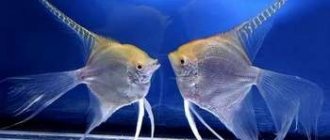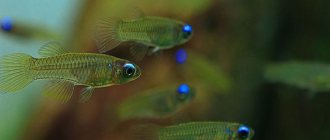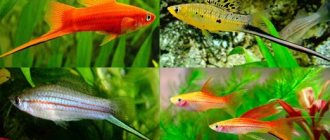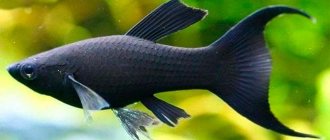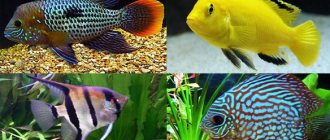Angelfish are the most popular aquarium representatives of the cichlid family. Their lack of bright natural coloring is compensated by the beauty of their long fins and unusual body shape. Angelfish floating in the water seem to float in weightlessness, and their long wing fins support them. With their sophisticated appearance, these “angel fish,” as they are nicknamed abroad, make a stunning impression.
Angelfish have a peaceful nature, making them compatible with many other types of non-aggressive fish. It is not surprising that they have gained popularity among many aquarium hobbyists.
Marble angelfish photo and description
Angelfish, or angelfish, as it is called in a number of countries. Now her image appears on the cover of every second book on aquarium management. The reason for this is its unusual, unearthly appearance and shape.
Angelfish have a flattened, crescent-shaped body with elongated fins. However, to the author, this shape does not resemble an angel or a crescent, but rather a sailboat. Which, coupled with the regularity of their movement around the aquarium in a flock of several fish, resembles a sailing regatta. The total body length is 15 centimeters. The height reaches from 25 to 30 centimeters. The marbled angelfish, being the most common of its species in the Russian Federation, is also easily recognizable due to its color. Her white body, like marble, is interspersed with black spots and streaks.
Table of basic parameters of maintenance, care and nutrition:
| What should be the volume of the aquarium for the Marbled Angelfish? | from 100 liters for a flock from 150 liters |
| What should be the temperature in an aquarium for angelfish? | from +24-28° C |
| What pH should be in the aquarium? | from 6.0-7.5 pH |
| What should be the hardness of the water in the aquarium? | from 2-10° dH |
| What should be the substrate for an aquarium? | any - small pebbles or coarse sand, suitable for living plantings |
| What kind of lighting should be in the aquarium? | 0.4-0.7 Watt/l daylight hours for at least 12 hours |
| What should be the movement of water in the aquarium? | moderate |
| Maximum fish size | length up to 15 cm. Height from 26-30 cm (a lot depends on the volume of the aquarium) |
| What does aquarium fish eat? | almost any live food: bloodworms, adult brine shrimp, coretra, tubifex and specialized dry food |
| Type of aquarium fish | peaceful, but small fish and shrimp can become food for them |
| Who is compatible with in an aquarium? | compatible with all peaceful ones that do not fit in the mouth |
| Lifespan of Marbled Angelfish | in aquariums they live up to about 10 years, but with proper care up to 20 years |
Sex determination during spawning
To accurately determine the sex of angelfish during spawning, you need to place a group of several mature individuals in a separate aquarium. When purchasing fish, it is best to buy 4-6 young fish at once and place them together. However, you need to select a large enough aquarium for the angelfish to feel comfortable. When selecting fish, it is advisable to purchase several small and larger individuals, as this will increase the likelihood of acquiring angelfish of different sexes, and hence the subsequent formation of spawning pairs.
To determine the sex of fish, you need to monitor the behavior of spawning individuals. When they reach puberty, they will begin to form pairs on their own and then spawn. From now on, you need to carefully monitor the behavior of the fish, as this will allow you not only to determine their gender, but also to understand exactly how they are distributed into pairs.
However, we must remember that individuals of the same sex can also form pairs; naturally, they will not have offspring. Sometimes spawning pairs show signs of attention, which can be affectionate and touching or somewhat aggressive.
With careful observation, you can notice that the female is laying eggs, but you will have to spend a lot of time at the aquarium so as not to miss the moment.
It is worth noting that the older the angelfish becomes, the easier it is to determine its gender, since at an older age the genitals drop lower, which makes it possible to clearly see them.
Natural habitat of the Marbled angelfish
Angelfish were first discovered in South America. Their habitat is numerous tributaries of the Amazon River. Like other famous inhabitants of those places, piranhas, angelfish are schooling fish. For their habitat, they choose places with weak currents and a large number of aquatic plants, the dense thickets of which provide them with good protection. The special shape of the body allows angelfish to easily move between these thickets. The marble variety of angelfish itself was bred artificially in the 60s of the last century.
Kinds
The angelfish genus consists of 3 species.
- Angelfish altum. The common name for this fish is “high angelfish.” It is often simply called "altum", using part of the species' Latin name.
- Leopold's angelfish. The scientist who included the fish in the biological classifier named it after the Belgian king, an amateur zoologist.
- Common angelfish. This type is sometimes called scalar.
The angelfish in its natural form has been a popular inhabitant of aquariums. Professionals involved in breeding fish for home aquariums began to improve what was good and developed new forms of angelfish. Three to four dozen varieties have appeared that do not exist in nature.
Silver angelfish. This is the equivalent of a wild angelfish. It has the same colors, the same shapes and the same sizes. This was once the only species of angelfish available in home aquariums.
Veil-tailed or veiled form of angelfish. This creation is the most luxurious. The tail and fins sway like a light veil in the flow of water. This form can have a wide variety of colors, which makes it even more valuable.
The colors of artificially bred angelfish can be very diverse. In addition to silver, angel fish have other “precious” colors: gold, diamond, pearl, platinum. Marbled angel fish look very impressive.
A very beautiful blue fish. This is one of the latest achievements of fish farmers. Aquarists call it the “blue angel”. This angelfish looks very impressive in the photo. In bright light, the illusion is created that the fish itself is glowing.
Multi-colored fish are in demand. There are two-color and three-color options. Spotted and leopard-colored fish are very popular. The aquarium angelfish has been bred to have more stripes on its body than usual. It is called "zebra".
There are about 40 aquarium forms with different morphological characteristics. This list is likely to constantly expand: aquarium fish are a fertile area of activity for breeders and geneticists.
The process of selection from centuries of development and consolidation of any of the characteristics has become more fleeting. It comes down to correcting the genotype of the fish with further consolidation of the trait that the gene of interest to the breeder carries.
For example, the blue angelfish was bred from an already existing platinum one. She was found to have a gene responsible for her blue color. Numerous crosses followed, resulting in the blue angel fish.
Angelfish Marble maintenance and care
The angelfish is a schooling fish, but very demanding on the volume of the aquarium. A 100 liter aquarium is suitable for two individuals. If you want to have a larger flock, you will need a tank with a volume of 150 liters or more. Also, the features of their physiology, in particular their height, indicate the need to choose a tall aquarium.
Fine soils (quartz, sand, small pebbles) are suitable as a substrate, which will allow you to plant greenery in this aquarium. Vegetation should be chosen that is strong, with a developed root system (don’t worry - angelfish do not dig plant roots), and not too demanding on the amount of light - this will help the plants to gain a foothold and grow successfully in conditions of constant flow and dim lighting.
Floating plants such as pistia and duckweed are also suitable for such an aquarium. As for lighting, lamps with a power of 0.4 - 0.7 W per 1 liter are suitable; you can safely choose the minimum threshold of these values, if the plants allow it. Daylight hours are from 12 to 14 hours. The water must be clean and running. The current power can be set to moderate. An aquarium also requires a filter, a compressor and a heater. A weekly 30% change of settled water will be required.
Matching
Experienced aquarists recommend the following: when purchasing adult fish, you should give preference to fish with typical characteristics, or purchase a ready-made pair right away. If you plan to buy small fish, then buy 8-10 angelfish fry with extensive and long fins, which will be divided into pairs.
A pair of angelfish is found on its own, and aquarists prefer not to interfere in this process. However, if you wish, you can select partners personally, for which two fish of the same size and age are placed in the same body of water. After a while, the two angelfish get used to each other and form a pair. There is a strict rule regarding newly formed couples: the couple is not separated, otherwise both halves will experience stress and will not soon decide to start a new family. You can determine the existing couple by their behavior:
- The two fish stay together without swimming far from each other.
- The male begins to chase the female, driving the fish into the corners of the tank.
What to feed the Marbled angelfish
In general, angelfish are unpretentious in food, but in order to avoid losses in the population, certain conditions must be observed. When choosing food, you should focus on natural food and its quality. Live and frozen daphnia, bloodworms, and brine shrimp work well. It is important to monitor their freshness, since angelfish have very sensitive digestion and stale food can lead to illness or even death. Experts note tubifex as a non-recommended food as a source of all kinds of infections.
These fish also eat dry food, which the owner can use as balanced vitamin supplements. But you shouldn’t rely on dry food as your main food. It has been proven that angelfish whose main diet is dry food grow to smaller sizes and their life expectancy is also shorter. Adults eat once a day, adolescents should be fed 2 times, in fractional portions, removing the remains of uneaten food using a siphon.
Differences in gender behavior
Many people wonder how to distinguish a female from a male angelfish based on the behavior of the fish. During the breeding season, angelfish, which generally lead a gregarious lifestyle, choose only one partner and create pairs. Even a beginner can identify an already formed “family”. The pair stays separately and looks for the most suitable place for laying eggs.
By nature, these amazing aquarium fish are monogamous. The loss of a partner as a result of separation from him or death is a huge stress for fish, which they often may not survive. Angelfish can injure themselves by hitting the walls of the aquarium or objects located in it, which leads to their death. This is why you can select partners for fish, but you should not destroy already formed pairs.
What fish get along with Marbled Angelfish in an aquarium?
When choosing neighbors, preference should be given to non-aggressive fish of similar sizes:
- gourami;
- lalius;
- ancitruses;
- corridors.
Small Neons, Danios, Guppy fry and other babies can easily become food for adult angelfish.
You should also not add aggressive fish species and other fin-picking angelfish (barbs, macropods).
Compatibility
The angelfish is a calm, non-aggressive fish. It feels most comfortable next to its relatives, other angelfish. In addition to the schooling nature, one has to take into account the fish’s commitment to its territory. The compatibility of scalars is not a very difficult question.
The main thing is that next to the angelfish there should live creatures that are suitable for the conditions dictated by the fish angels. This is, first of all, clean and warm water. For example, goldfish feel better in cooler water, so they are not compatible with angelfish.
Living in the same aquarium with barbs is a disaster for angelfish. These lively fish pluck the fins of the angelfish. In addition, fast, overly active aquarium inhabitants cause stress in angelfish, which affects their health, appearance and offspring.
Angel fish do not always live up to their name. They can display a predatory nature. The offspring of viviparous fish, guppies, swordtails and mollies, can suffer from them. Although these fish are considered good neighbors of angelfish.
Labyrinth fish - gourami, thornets - can keep angel fish company in the same aquarium. Catfish, whose living space has little overlap with the territory of brooding angelfish, are acceptable neighbors for angel fish, although they, rummaging in the sand, can literally muddy the waters.
Aquariums with angelfish do not require a special selection of plants. Angel fish do not conflict with their green neighbors. Do not pluck them and do not damage the roots. On the contrary, algae are natural protectors of angelfish.
How to distinguish a male Marbled Angelfish from a female
There are many signs by which you can distinguish individuals of the opposite sex in a pair of angelfish. Males of the same age are much larger. The male's forehead is convex, the female's forehead is sunken. The front fin of female angelfish is smooth, while in the opposite sex it is forked. Number of stripes on the dorsal fin: female up to 6 stripes, male from 7 stripes.
Features of the genital organs of fish
Angelfish are considered quite attractive and unusual inhabitants of the aquarium. Every owner of these amazing creatures should know how to distinguish a female from a male. You need to wait until the individuals grow a little and reach puberty, since after that they need some care.
To determine which angelfish is male and which is female, you need to examine their genitals. As soon as the fish becomes an adult, a small tube begins to be visible near its anus: in the female it is the ovipositor, and in the male it is the vas deferens. The reproductive organs are located behind the ventral paired fins and become more visible during spawning. To better examine the genitals of the fish, it is necessary to transplant it into a separate aquarium.
The gender of a fish can also be determined by the shape of its genitals. In males, the vas deferens has the shape of a pointed narrow tube that looks like the tip of a pencil. In the female, the ovipositor has a cylindrical and more rounded shape.
What diseases do Marble Angelfish have?
Angelfish have many diseases; we will describe the main diseases, their symptoms and treatment.
Gill flukes in angelfish symptoms
Poor appetite. Redness of the gills. Fading of color. The fish often spends time at the surface of the water, head up. Treat by increasing filtration. Addition of drugs based on praziquantel: azipirin, Azinox-Plus and others.
Worms in angelfish
The fish doesn't eat. The appearance is emaciated, while the abdomen is swollen. Moves little. Redness of the eyes. Treat by adding anthelmintics to the water.
Hexamitosis in angelfish: signs and treatment
Poor appetite. Abdominal bloating. Darkening of color. Erosion of the scalp, formation of ulcers. Destruction of fins. Treat by increasing the temperature in the aquarium +34-35° C. Increased air supply. Adding metronidazole to water.
Ammonia poisoning symptoms in fish
Darkening of the body. Redness of the gills. Unusual behavior: moving sideways, trying to jump out of the aquarium. Treat with increased water changes up to 2 per week. One change must be made immediately. Increase filtering. Add a little hydrogen peroxide to the water.
